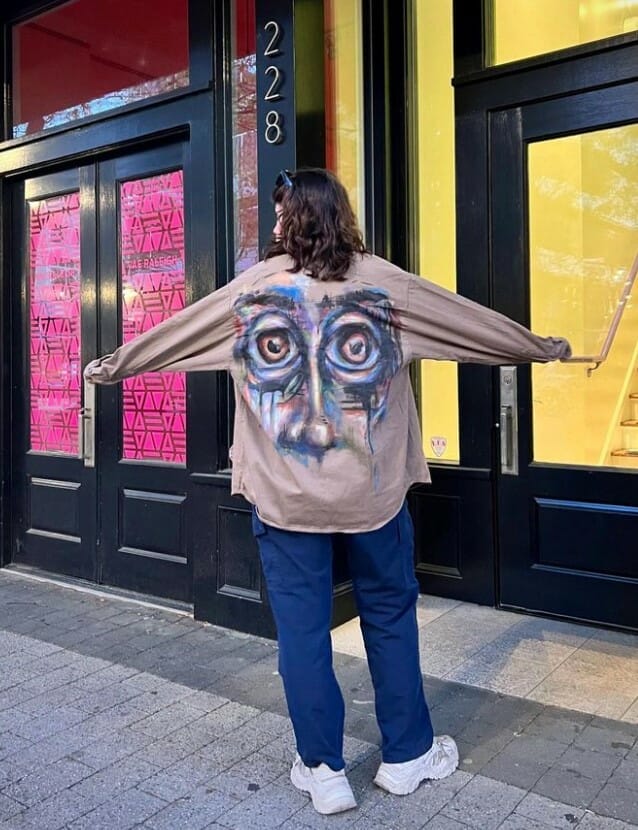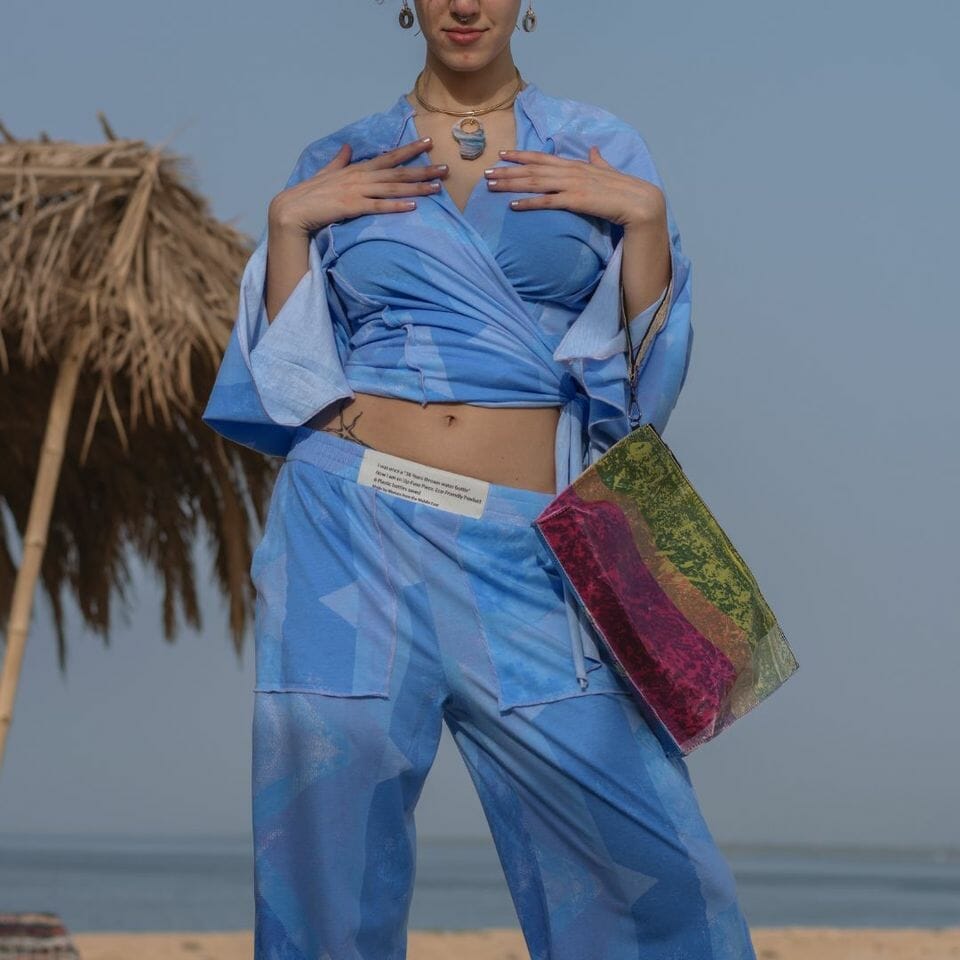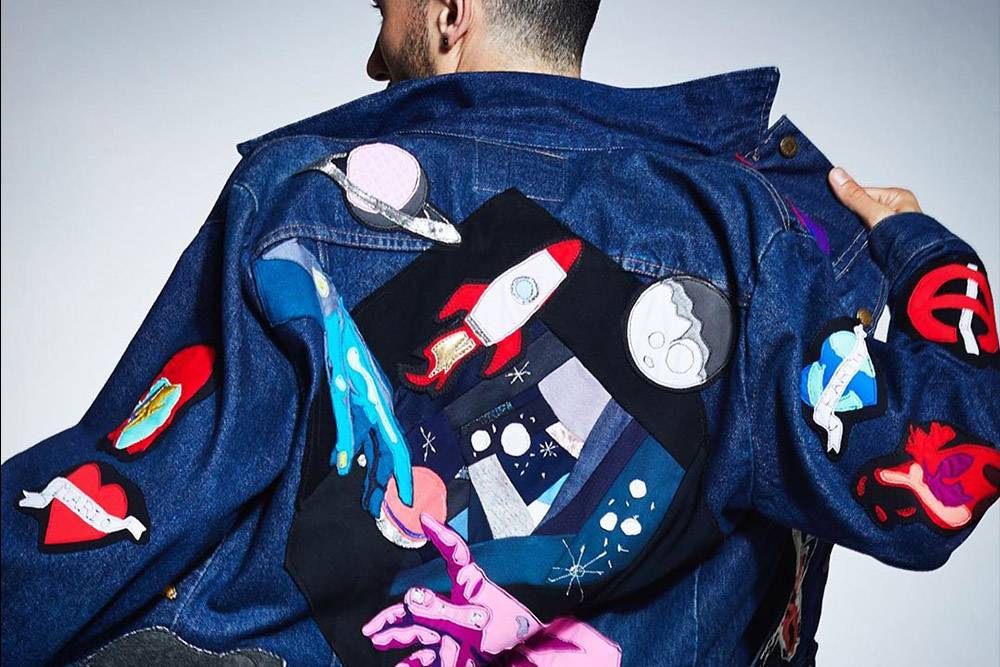Eco-Stylist is reader supported. When you shop through links on our site, we may earn a commission. Learn more here.
What is Upcycled Clothing?
Upcycled clothing is clothing made using existing used clothes, fabric scraps, or deadstock materials and adding to it, reconstructing it, or reimagining it in some way which increases its life and/or value compared to the original. Whether it’s something completely new created from scrap materials, an old pair of jeans fixed with patches and modified with embroidery, or an old dress reconstructed into a new style, upcycled clothing can take many different forms all centered around the idea of creating something new from the old.
Upcycling is often seen as an alternative to thrifting because many clothes from thrift stores and second-hand stores still end up in landfills, but the goal of upcycling is to give new life to those unloved pieces to create something new and wearable without harming the planet. One of the best benefits of upcycling is the possibility to have one-of-a-kind clothing specifically tailored to your tastes, instead of something that’s mass-produced off the rack.
But upcycling clothing is a lot more than an alternative: it’s art, it’s fashion, and it’s sustainable.
Re.Statement: Your One Stop Shop for Upcycled Clothing Brands


RE.STATEMENT is an upcycled clothing marketplace created by Hannah M. Le where she makes it easy to shop for unique and sustainable pieces of clothing from over fifty designers. Each piece on the site is one of a kind, each upcycled, reworked, and reimagined by independent designers.
RE.STATEMENT has a wide variety of designs and styles, from painted denim jackets to patchwork sweaters, and with new upcycled clothing collections dropping every month, there is sure to be something that grabs your attention. Whether you care about looking good, sustainability, or both, RE.STATEMENT is by nature a gateway into eco-conscious consumerism.
RE.STATEMENT is a woman owned, BIPOC-owned, small sustainable business based in Houston, TX. They make it easy to shop one of a kind upcycled clothes by curating the best options for you. So go check them out!
Up-fuse: Stylish Accessories That Reuse Local Waste

Up-fuse makes beautiful one-of-a-kind bags and accessories upcycled from local waste materials in Egypt. This women-owned brand sources waste materials from old tires, plastic bags, and plastic bottles, and upcycles those materials into durable (and super stylish) products. Their goal is to lessen environmental impact and to produce a local product that spreads environmental awareness and creates job opportunities for women in Egypt.
Their gorgeous upcycled bags and accessories support more than 80 artisan women and prevent plastic waste from being dumped in our oceans and seas on a daily basis. Up-fuse sources pretty much everything locally in Egypt, and is not only a sustainable brand but one that gives back to and enriches its community.
Frankie Collective: Wearable Upcycled Fashion

Frankie Collective is trend forward upcycling in the best way. Their reworked sweat sets, tanks, and sweaters are made with brand-name garments destined for the landfill. Their reworked designs feature fabrics from Nike, Carhart, Tommy Hilfiger and so much more, all recreated into something completely new.
One of the unique things about Frankie Collective is that some of their upcycled styles are available in multiple sizes, something uncommon in the other upcycled brands we feature, making their innovative designs available to more people.
Zero Waste Daniel: Colorful Clothes that Recycle Fabric Waste

Zero Waste Daniel is a zero-waste lifestyle pioneer who makes genderless patchwork swimsuits, clothes, and accessories from repurposed scrap fabrics sourced from local New York factories, saving them from the landfill.
Fabric waste is kept at zero as all the pattern-making techniques, appliqués, tiled mosaics, and embellishments use one hundred percent of the textile goods that are brought into the shop, eliminating textile waste.
Fun fact: each piece from Zero Waste Daniel saves roughly one pound of fabric from hitting a landfill!
Topiku: Sustainable Fashion Meets Baseball Caps

Topiku offers a casual baseball cap made entirely from waste materials and is ethically made in Indonesia. They offer individual orders as well as mass orders, all customizable and of course, sustainable.
Buckets are salvaged from landfills and reused as brims, leather scraps are collected from local businesses and converted into patches and straps, while fabrics are upcycled directly from garment manufacturers’ leftover or deadstock textiles. Since there are no new fabrics in the mix, the need for the energy and water-intensive stages of fiber, yarn, fabric, and dyeing production is eliminated, significantly reducing their carbon footprint.
Shop Topiku | Use code ECOSTYLIST10 for 10% off your order
What are the Best Ways to Upcycle Clothes of My Own?
Upcycling old clothing is a sustainable way to DIY something new out of an old piece of clothing that you may not love anymore. There are so many ways to rework clothes with a variety of different mediums including sewing, painting, bedazzling, tie-dying, cutting, or embroidering.
If you’re new to upcycling it doesn’t have to be complicated, it can be as simple as cropping an old t-shirt with a pair of scissors or tie-dying an old sweatshirt or as hands-on as creating an entirely new garment from an old bedsheet. Upcycling can also be an amazing sustainable creative outlet allowing you to reimagine anything to fit your personal style no matter your skill level.
For more DIY ideas, check out our article 10 ways to repair or repurpose your old clothes.
Why is Upcycling Clothes Beneficial?

Aside from the amazing environmental impact, upcycled clothes are an amazing way to express your own personal style in a way that no one else will be able to recreate. Whether you prefer to do it yourself or buy from one of these upcycling brands, you’re sure to end up with clothing that is uniquely you.
Plus, buying upcycled clothes supports independent brands and designers!
Where to Buy Upcycled Clothing Brands?
Start with our top picks, all listed above for you in this article. If you’re left wanting more upcycled clothing brands check out your local thrift and vintage markets for local upcycling designers in your city.
For more sustainable fashion, check out the Eco-Stylist shop where you’ll find more amazing sustainable brands, all with the Eco-Stylist stamp of approval.
How is Upcycling and Recycling Clothing Good for the Environment?
Thanks to fast fashion, more than 50% of new clothes end up in a landfill in less than one year. Upcycling helps change that.
Upcycled fashion lowers the amount of discarded materials sent to landfills by the fashion industry. It also reduces the production of new materials which is better for the planet because it reduces air pollution, water pollution, and greenhouse gas emissions that are created by textile production.
Upcycling vs. Used Clothing
Thrifting and upcycling can both involve re-using pre loved clothes, but there’s a major difference. Upcycling implies the piece was upgraded, extending its life and/or value. For example, upcycling might take a pre-loved garment or dead stock fabric and create something new from it, which not only reuses the materials but upgrades its value.
Upcycling and thrifting both give new life to old clothes and accessories and they often go hand in hand as many DIYers use second-hand clothing for their projects. Overall both ways of sustainable shopping lessen textile waste and have a positive impact on the environment.
Upcycling vs. Recycling
Recycling involves turning something used into something of equal value to the original (like a glass bottle into a glass bottle), whereas upcycling implies turning it into something better than before. For example, turning an old t-shirt into a new one is recycling, but turning t-shirt scraps into a new patchwork t-shirt is upcycling.
As upcycling gains popularity, there has been a trend where upcyclers on Instagram take brand new pieces from brands like Champion and “upcycle them” into something new. This is a gray area for upcycling and many (including us) would argue that this is not upcycling at all.
As mentioned before, upcycling implies that you upgrade a piece, extending its life and/or value. Turning a new piece into another new piece isn’t really upgrading it, whether the value increased is subjective, and at the very least it’s not more sustainable. Calling this art is fine, but calling it sustainable is greenwashing. In reality, turning a new piece into another new piece is more like repurposing or recycling than upcycling.
*Featured image from RE.STATEMENT.

Bella Tabor is a writer at Eco-Stylist. She currently studies fashion communication at Iowa State University. Bella will be traveling to Italy this fall to continue her studies across the globe!









